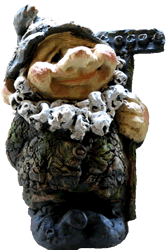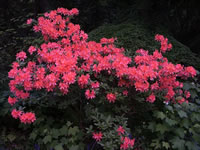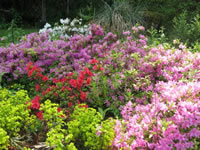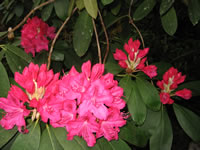How to Plant, Grow and Care for Rhododendrons and AzaleasWhen you are shopping for a Rhododendron or Azalea, there are many factors to consider. Whether it is sold in a pot with it's rootball wrapped in burlap is of little consequence, nor is the size of the plant. Many nurseries provide tags on their plants which will tell you the name and blooming period, as well as the eventual size of the plant and how cold hardy it is. Some have fragrant flowers (mainly Exbury Azaleas). All Azaleas are members of the Rhododendron family but not all Rhododendrons are Azaleas. They can be low growing, and never reach a height of more than two feet, but others can grow as tall twelve feet. |
||||||
|
||||||
|
Plant your Rhododendrons in an area that receives a few hours of morning sun, but receive at least partial shade during the very hottest part of the day. Dig your planting hole twice as wide and 1 1/2 times as deep as the rootball. Mix compost and peat moss into the soil. Add course builders sand or grit if it is necessary to improve your drainage. When you remove the plant from the pot, use your fingers to loosen up the roots a little to get them to grow into the new soil. When you plant Azaleas or Rhododendrons, they should be placed in the ground so that their root ball is slightly higher than the surrounding. They will resent it if soil is pushed up against the trunk. Sprinkle a small amount of Rhododendron food into the hole at the dripline of the plant. Fill in the hole and water it very thoroughly. Azaleas resent drying out, so use some kind of mulch to conserve moisture in the soil. You can use leaves, bark, compost or whatever. The buds for next years blooms will be formed this year, so it important that the faded blooms are removed, otherwise you will not get a flower on that stem next year. An acid type Rhododendron fertilizer should be applied after the plant has finished blooming. Rhododendron pruning consists mainly of removing the spent flowers, and cutting back longer branches which may spoil the symmetry of the plant.
View more of the Rhododendrons of Cedar Hill
|
||||||
Search The Garden Helper:



